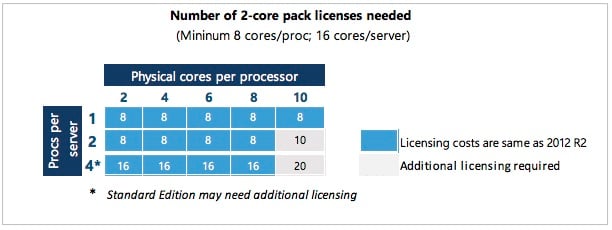
Posted on 12/03/2015 6:53:38 PM PST by dayglored
"We put in more, so you'll pay by the core"
Microsoft looks to be moving to per-core licences, rather than per-CPU licences, for Windows Server 2016.
"Directions on Microsoft" chap Wes Miller tweeted links to a "Pricing and licensing FAQ" for Windows Server 2016 and System Center 2016 Standard and Datacenter Editions. Dated December 2015, the meat of the document offers this description of Redmond's future licensing plan:
The licensing of Datacenter and Standard Edition will move from processors to physical cores, which aligns licensing of private and public cloud to a consistent currency of cores and simplifies licensing across multi-cloud environments. Licenses for servers with 8 cores or less per proc will be same price as the 2012 R2 two-proc license price.The document goes on to explain how you'll be able to buy licences, as follows:Core licenses will be sold in packs of 2 for incremental licenses needed above the required 8 cores per proc. The Standard Edition of Windows Server and System Center will license up to 2 VMs when all of the physical cores on the server are licensed.
Core licenses will be sold in packs of two licenses. Each processor will need to be licensed with a minimum of 8 cores, which is 4 two-core packs. Each physical server, including 1 processor server, will need to be licensed with a minimum of 16 cores, which is 8 two-core packs. Additional cores can then be licensed in increments of two cores (one two-core pack) for gradual increases in core density growth. Standard Edition provides rights for up to two virtual OSEs when all physical cores on a server are licensed (minimum of 8 cores per proc and 16 cores per server).Microsoft's documents say the company is doing this to make cores the common currency when licensing Windows Server. Redmond's already made moves in this direction on Azure, so per-core licensing for on-premises deployments means it should be easier to understand hybrid cloud costs.
There will be pain for users. As the graphic below shows, those of you with servers boasting two or four CPUs, and 10 or 20 cores, will require "additional licensing."

The company's justification for the changes is that Windows Server and System Center have lots of new features. So cough up, even if you don't plan on using them. Redmond can also point to the fact that it offers per-core licensing for other on-premises software, such as SQL Server and BizTalk, so it's actually doing you a favour by being more consistent.
Another nugget of information revealed in the FAQ is that Windows Nano Server is included as part of the licensing of the edition from which it is deployed.
You don't need to do anything about this for now. Microsoft says that "Customers will then begin transacting Windows Server and System by core-based licenses at the time of their software assurance renewal or at the time of net new license purchase outside of any Microsoft agreements."
In case Microsoft takes down the PDFs referred to in the Tweets, we've popped them into Dropbox here and here.

Linux rulz......
+++++++++++++++++++++1!
LOL, M$ Droolz...
Unbelievable.
Apparently Ballmer’s team could use a larger budget....
My MS license true up is in March. Can’t wait... We get higher costs every year. Everyone wants iPads and mobile devices, well guess MS charges us for these devices because they touch either an exchange server or a SQL server in some way.
Red Hat charges for support. Linux is free to use, but big enterprise users like to have tech support. You would think they would just have employees who know what they’re doing.
Well, "RedHat" is free -- entirely -- if you use the CentOS distro and rely on the community for knowledge base and forum help. It's the identical code as RHEL.
I honestly don't know these days what RedHat's price schedule is for their installation and support. Someone else will doubtless chime in...
4 cores should be the standard. It’s not like you’re buying an OS for each core on the same server.
That's what we do, albeit a small enterprise.
Golly, we’re still getting along okay with Win2008 R2 and MSSQL 2008.
But you’re telling me corporations are spending money on IT infrastructure again? You mean, actually buying new rack mounted server blades and migrating to new server OS versions?
Wow, wonder what that’s like. I’m pretty sure most of the planet is still using Office 2007.
every announcement they make lately has made me cement my move away from them.
We bitch about it, but I think we all knew change was a constant when we sign on.
IMO that was the last version of Server I could use without puking. 2012 R2 grafted Metro and it makes me ill every time I have to manage the machines that have it.
> But you're telling me corporations are spending money on IT infrastructure again? You mean, actually buying new rack mounted server blades and migrating to new server OS versions?
It's a brand new world out there!!
> Wow, wonder what that's like. I'm pretty sure most of the planet is still using Office 2007.
Office 2003 for me, with the 2007 Compatibility Pack so I can read/write the zipped XML file formats. Seriously. I just today installed 2003 with the pack on a brand-fresh Windows 10 VM (hosted on my Linux workstation) so I have something that opens Word Docx correctly.
Yeah, I know about LibreOffice and OpenOffice, and I run those too. But some days I need the real thing because of what people send me. arrrrrgh.
Redhat licensing is pretty steep as well, at least in my humble opinion. However, for non-prod servers you can always use CentOS, which is the same thing with cosmetic changes minus support. You can save a =lot= of money that way.
There are also more free alternatives, but in a production environment, you really want some kind of support.
If it weren’t for exchange...
TRUE THAT.
Disclaimer: Opinions posted on Free Republic are those of the individual posters and do not necessarily represent the opinion of Free Republic or its management. All materials posted herein are protected by copyright law and the exemption for fair use of copyrighted works.